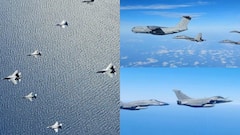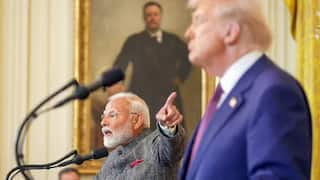What India Stands To Gain From India-Australia Trade Deal That Is Set To Boost Strategic Partnership
After the India-Australia trade agreement, the two nations are looking forward to a more comprehensive trade treaty, negotiations for which are expected to commence in January.

With the Australian Parliament last week ratifying the India-Australia Economic Cooperation and Trade Agreement (IA-ECTA), the landmark trade promotion bilateral treaty concluded this year in April, a major void in the strategic partnership between the two vibrant democracies now stands filled. India and Australia in recent years have given a big push to bilateral strategic ties by joining hands for international alliances like QUAD, Malabar naval group, a trilateral Supply Chain Resilience Initiative (SCRI), Indo-Pacific Economic Framework etc. Both nations are already members of the Commonwealth, an organisation of former British colonies. A deeper economic and trade relation will certainly give a new momentum to bilateral strategic partnership as both the countries would have a stake in each other’s security, stability and prosperity — as Prime Minister Narendra Modi put it in a tweet: “the trade deal will further strengthen India Australia Comprehensive strategic partnership”.
The move by the new Anthony Albanese government of the Labour Party to place before Parliament a deal negotiated by the previous Labour Party government headed by Scott Morrison shows that a bipartisan consensus has now clearly emerged in Australia for developing strong economic and strategic partnership with India. Australia used to be a strong critic and opponent of India’s nuclear programme but later felt necessary to negotiate civil nuclear cooperation deal with India, which has cleared the obstacles for supplying nuclear fuel uranium to Indian nuclear power plants. Over the years, both countries have taken part in joint military exercises held in each other’s countries and gradually emerged as joint guardians of peace and stability in the Indian Ocean.
The China Angle
The ECTA approval is significant in view of rising tension between Australia and China. China is Australia’s biggest trade partner but after a recent spat between the two in the wake of Covid-19 pandemic and Australia joining the three-nation military alliance with the United Kingdom and the USA, the Australia-China relations have gone haywire. As Australia wants to diversify under a new strategy, India has been found to be a natural alternative trade partner. It’s a win-win deal for both nations. Australia sees big potential in India as a big market for its various products. Roughly, one third of Australia’s exports are destined to China whereas imports account for 27 percent. Exports to India account for a miniscule 3.7 percent whereas the imports share is only 2.4 percent. It is expected that a lot of Australian investment and trade will be diverted to India from China after the implementation of IA-ECTA.
With the new trade agreement in place, both the countries have set an ambitious goal of doubling the trade to US $25 billion in the next five years. The leadership of the two countries are not going to rest with this trade agreement, but are looking forward to a more comprehensive trade treaty, negotiations for which are expected to commence in January. As India negotiates free trade agreements with advanced nations like the UK and those part of the European Union, Australia emerged as the first developed country with which India has signed such a landmark deal. In fact, the India-Australia trade deal can be used as a template for trade deals with other developed countries.
Credit goes to Indian negotiators who impressed the Australian counterparts in leaving the dairy and agriculture sector out of the domain of bilateral trade agreement. In fact, the issue of including dairy and agriculture within the ambit of the trade deal had been the bone of contention between the two countries for long. The two sectors are considered most sensitive for the Indian economy, on which depends the livelihood of more than half of the rural population. The labour-intensive sectors like textiles and apparels, leather footwear, and furniture, several engineering products, jewellery, sports goods etc are expected to gain most.
In all, the agreement will facilitate duty-free access to over 6,000 broad categories of Indian products in the Australian market and will gain maximum from this deal. Australia has agreed to eliminate duty on 100 percent of tariff lines, which will benefit Indian labour intensive sectors. The Indian pharmaceutical sector will also gain as drugs approved in other developed countries will get faster approval in Australia. As far as trade in services are concerned, the annual quota of 1800 for yoga teachers and Indian chefs have been fixed. Also, the duration of post-study work visa has been approved for 18 months to four years .
At present, India’s exports to Australia mainly include manufactured goods such as petroleum, medicaments, diamonds, jewellery, railway coaches and vehicles, milled rice, herbicides. While such goods constitute 72 percent of India’s exports to Australia, 82 percent of India’s imports from Australia are coal, gold, copper ore, aluminium oxide, liquefied natural gas, manganese ore, aluminium waste, pigments, lentils etc.
How ECTA Coupled With Critical Minerals Deal Will Help India
Significantly, prior to giving approval to IA-ECTA , both countries had inked India-Australia Critical Minerals Investment partnership. Combined with ECTA, the mineral partnership will reduce India’s dependence on China for supply of critical rare earths, over which China has got world monopoly.
Australian Minister For Resources Madeleine King recently said: “Australia has the resources to help India fulfil growing demand for critical minerals to help India’s space and defence industries, and the manufacture of solar panels, batteries and electric vehicles. This will help advance critical minerals projects in Australia while diversifying global supply chains.”
Critical and strategic minerals are vital for development of India’s defence, nuclear and space sectors, and Australia can become India’s most trusted supplier. Australia will encourage Indian investors to own critical minerals mines, which will facilitate Indian entities emerge as major suppliers of rare earth materials. Australia has large lithium and cobalt deposits besides other critical minerals, which can be exploited by Indian mining firms. Besides, duty-free imports of Australian raw materials like nickel, aluminium, copper, manganese etc will boost the competitiveness of Indian industries. With Australia easing visa regimes especially for Indians, more and more Indian students and workers are expected to study and work in the country, where the Chinese are currently the largest migrant communities. While around 1.4 million people of Chinese origin account for 5.5 percent of the Australian population, Indians are the second largest with approximately 8 lakhs constituting 3.1 percent of the population of 2.57 crore.
Thus the win-win trade partnership agreement will not only increase bilateral trade manifolds in the coming years but is also expected to further increase the share of Indians in Australia. The trade agreement will further deepen the economic ties and people-to-people relationship, which will have a multiplier effect on the rationale of advancing and taking care of each other’s strategic interests.
The author is a senior journalist and strategic affairs analyst.
[Disclaimer: The opinions, beliefs, and views expressed by the various authors and forum participants on this website are personal.]






































